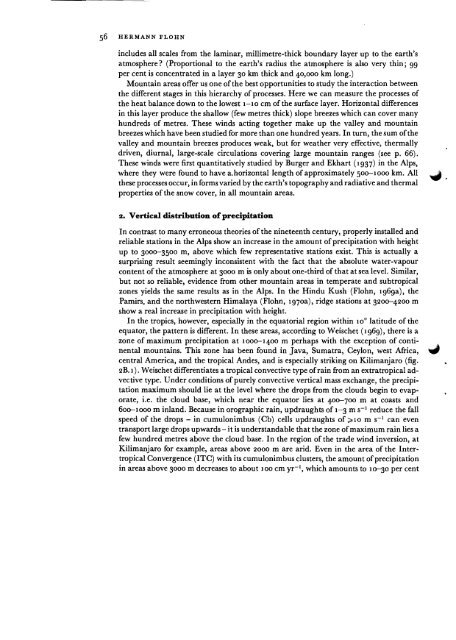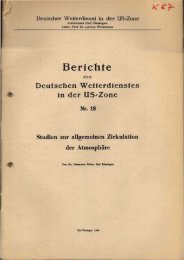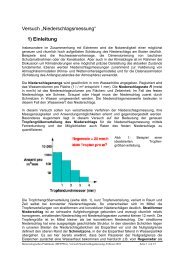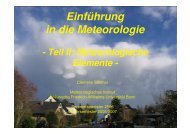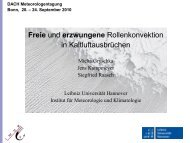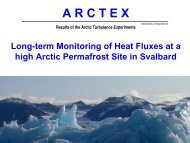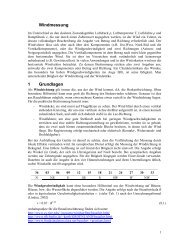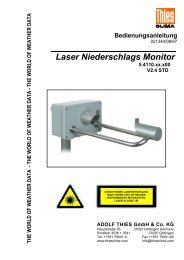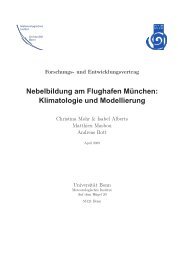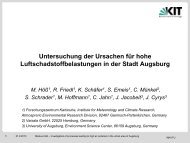Contribution to a comparative meteorology of n10untain areas
Contribution to a comparative meteorology of n10untain areas
Contribution to a comparative meteorology of n10untain areas
Create successful ePaper yourself
Turn your PDF publications into a flip-book with our unique Google optimized e-Paper software.
56 HERMANN FLOHNincludes all scales from the laminar, millimetre-thick boundary layer up <strong>to</strong> the earth'satmosphere? (Proportional <strong>to</strong> the earth's radius the atmosphere is also very thin; 99per cent is concentrated in a layer 30 km thick and 40,000 km long.)Mountain <strong>areas</strong> <strong>of</strong>fer us one <strong>of</strong>the best opportunities <strong>to</strong> study the interaction betweenthe different stages in this hierarchy <strong>of</strong> processes. Here we can measure the processes <strong>of</strong>the heat balance down <strong>to</strong> the lowest 1-10 em <strong>of</strong> the surface layer. Horizontal differencesin this layer produce the shallow (few metres thick) slope breezes which can cover manyhundreds <strong>of</strong> metres. These winds acting <strong>to</strong>gether make up the vaHey and mountainbreezes which have been studied for more than one hundred years. In turn, the sum <strong>of</strong>thevalley and mountain breezes produces weak, but for weather very effective, thermallydriven, diurnal, large-scale circulations covering large mountain ranges (see p. 66).These winds were first quantitatively studied by Burger and Ekhart (1937) in the Alps,where they were found <strong>to</strong> have a.horizontallength <strong>of</strong>approximately 500-1000 km. Allthese processes occur, in forms varied by the earth's <strong>to</strong>pography and radiative and thermalproperties <strong>of</strong> the snow cover, in all mountain <strong>areas</strong>."filii.2. Vertical distribution <strong>of</strong>precipitationIn contrast <strong>to</strong> many erroneous theories <strong>of</strong>the nineteenth century, properly installed andreliable stations in the Alps show an increase in the amount <strong>of</strong>precipitation with heightup <strong>to</strong> 3000-3500 m, above which few representative stations exist. This is actually asurprising result seemingly inconsistent with the fact that the absolute water-vapourcontent <strong>of</strong> the atmosphere at 3000 m is only about one-third <strong>of</strong> that at sea level. Similar,but not so reliable, evidence from other mountain <strong>areas</strong> in temperate and subtropicalzones yields the same results as in the Alps. In the Hindu Kush (Flohn, 1969a), thePamirs, and the northwestern Himalaya (Flohn, 1970a), ridge stations at 3200-4200 mshow a real increase in precipitation with height.In the tropics, however, especially in the equa<strong>to</strong>rial region within 10 0 latitude <strong>of</strong> theequa<strong>to</strong>r, the pattern is different. In these <strong>areas</strong>, according <strong>to</strong> Weischet (1969), there is azone <strong>of</strong> maximum precipitation at 1000-1400 m perhaps with the exception <strong>of</strong> continentalmountains. This zone has been found in Java, Sumatra, Ceylon, west Africa, ..",central America, and the tropical Andes, and is especially striking on Kilimanjaro (fig.2B.l). Weischet differentiates a tropical convective type <strong>of</strong>rain from an extratropical advectivetype. Under conditions <strong>of</strong>purely convective vertical mass exchange, the precipitationmaximum should lie at the level where the drops from the clouds begin <strong>to</strong> evaporate,i.e. the cloud base, which near the equa<strong>to</strong>r lies at 400-700 m at coasts and600-1000 m inland. Because in orographic rain, updraughts <strong>of</strong> 1-3 m S-I reduce the fallspeed <strong>of</strong> the drops - in cumulonimbus (Cb) cells updraughts <strong>of</strong> ;;;':10 m S-I can eventransport large drops upwards itis understandable that the zone <strong>of</strong>maximum rain lies afew hundred metres above the cloud base. In the region <strong>of</strong> the trade wind inversion, atKilimanjaro for example, <strong>areas</strong> above 2000 m are arid. Even in the area <strong>of</strong> the IntertropicalConvergence (ITC) with its cumulonimbus clusters, the amount <strong>of</strong>precipitationin <strong>areas</strong> above 3000 m decreases <strong>to</strong> about 100 em yr- I , which amounts <strong>to</strong> 10-30 per cent


